0500: The sun slowly begins to rise over the Philippine Sea, splashing color onto the camouflaged escort carrier USS St. lo, and her squadron of Avengers and Wildcats.

0500: A pilot briefing was held on the USS St. Lo. Pilots were given their assignments and patrol areas. Assignments for the day were standard anti-sub patrols.

0515: "Man Your Planes" is ordered. Pilots and their crew board their assigned aircraft and prepare for takeoff.

0530: An ASP of two VT for the Leyte Gulf area and an ASP of four VT were launched by the St. Lo.

0650: An ASP plane from the St. Lo piloted by Ensign Brooks reports contact with a Japanese fleet about 25 miles from the St. Lo, part of Task Unit 77.4.3, code named "Taffy 3." The Japanese force was estimated by Ensign Brooks as consisting of four BB, four CA, two CL and 10 to 12 DD. General Quarters was sounded, and all aircraft launched immediately for attack.

0658: The splashes of the first salvoes were observed. A salvo was observed to splash ahead of the ship slightly off the starboard bow.

0738: The closest Japanese ships were now within 14,000 yards, and many salvo splashes were noted throughout the formation. All ships were making maximum smoke, and the CVEs were firing their single 5" guns. The St. Lo singled out a cruiser at 14,000 yards astern, closing, apparently not under fire from any of the other ships.

0930: Ensign Brooks lands on The Marcus Island, CVE-77 of Taffy 2, to refuel, rearm and report the status of the enemy fleet.

0940: Ensign Brooks debriefs his superiors aboard the USS Marcus Island on the sightings and position of the Japanese fleet.

1020: As the Japanese fleet retreats under the belief that another naval fleet is approaching, Lts. JG Wayne Hammett and Larry Budnick give chase. Flying their FM2 Wildcats, they choose a heavy cruiser and begin to strafe the ship, approximately 50 miles away from the St. Lo.

1000: At approximately 1000, Lt. Yukio Seki of the 201st Kokutal takes off from Marakat Airbase in the Philippines, as the first Kamikaze pilot in the Japanese military to sink a US surface vessel.

1010: All units of the Japanese f0rce had ceased firing, and their opening courses definitely indicated they were retiring northwest. The St. Lo had suffered no structural damage, and all were secured from general quarters.

1050: Numerous planes, believed to include both friendly and enemy, were seen at 1000-3000 feet ahead and on the starboard bow. These planes moved aft to starboard and one of them, when about abeam to starboard, went into a right turn toward the St. Lo. The after starboard guns opened on him, but with no apparent effect. This plane, a Zeke 52, stowing a single bomb, continued his right turn into the groove, and approached the ramp at very high speed.

1053: After crossing the ramp at not over 50 feet, Lt. Seki pushed sufficiently to hit the deck at about the number 5 wire, 15 feet to the port side of the centerline. There was a tremendous crash and flash as his bomb exploded.

1053: The Zeke continued up the deck, leaving fragments strewn about, and its remnants went over the bow.

1053: Crew members aboard another ship in the Taffy 3 fleet watch as their sister ship fights to survive under attack.

1055: Piercing the flight deck, the bomb proceeded to the hangar deck, exploding within, during rearming and refueling of the aircraft below. This particularly heavy explosion threw part of the flight deck and other debris clear of the ship.

1055: There was a hole in the flight deck with smoldering edges which sprang into flames. Hoses were immediately run out from both sides of the flight deck, and water started on the fire. Smoke was coming through the hole from below, and on both sides of the ship, from the hangar.

1057: After several explosions originated from below deck, medics proceed to care for the wounded.

1058: The destroyers of the Taffy 3 begin to lay a cover of smoke to hide the St. Lo.

1058: Captain McKenna decided the ship could not be saved. With the smoke and flame, he was even uncertain as to whether the after part was still on the ship. The word was passed "stand by to abandon ship" and the order given to stop all engines, which appeared to get through. As soon as the Captain considered the ship sufficiently near to dead in the water, he gave the order to abandon ship.

1107: Number six of an estimated eight explosions, this blew out part of the starboard side as the last few people abandon the St. Lo, with assistance as needed.

1124: The Captain estimates that he was in the water between five and ten minutes when the USS St. Lo sank at about 1125. When he left, she had a heavy list to port as a result of the last explosions.

1125: The USS St. Lo sank at 1125 on October 25, 1944. She had been in commission for one year. The USS St. Lo was 512 feet, 3 inches long from aft to stern, 65 feet wide, and rested 65 feet above the water fully loaded. Of her crew totaling 889, 114 lives were claimed. Due to the detailed report of Captain McKenna, and other officers of the Taffy 3 Task Unit, this saga could be told and illustrated, lest we forget.
 About the artist: After retiring from a long career as a newspaper illustrator, artist John Downs worked as a historical illustrator for the United States Air Force. John’s artwork has been displayed in the United States Pentagon and at the Smithsonian Institution. His inspiration for these works are his two older brothers, Jim and Joe, who both served as aerial gunners during World War II.
About the artist: After retiring from a long career as a newspaper illustrator, artist John Downs worked as a historical illustrator for the United States Air Force. John’s artwork has been displayed in the United States Pentagon and at the Smithsonian Institution. His inspiration for these works are his two older brothers, Jim and Joe, who both served as aerial gunners during World War II.

